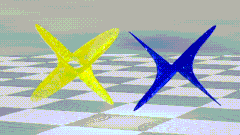While I can’t speak to the shape of the Earth, as I haven’t personally done these experiments or been high enough off the ground to know (and I haven’t sifted through each and everything NASA has put out, though I do know that their nickname of “Never A Straight Answer” is more than well-earned), I can give you some potentially more redpilled thought points.
As for the simulation bit, that never made sense to me when people say “that seems not like how reality should behave, therefore this is a computer world.” No.
But, we have identified a “quantum fluid/foam” as the primary constituent of all expressions of energy (e.g. matter). Which, when combined with the “Relativistic Drag” that a pair of geosynchronous satellites (forgot their names) detected, as well as the descriptive properties and/or attributes of the Quantum Fluid/Foam and even Dark Energy, we basically have confirmed, scientifically, that the Ether/Aether definitively exists and is just called something less taboo. The satellites were basically performing the Michelson-Morley experiment in space (which is what they wanted to do, but couldn’t).
Some people want the Ether to be made of particles, because they feel that a “non-physical” explanation for anything is somehow unscientific and incompatible with anything except “ugh, religion and whateverrrr.” Personally, I think it could help bridge the gap between the sciences and philosophy of many kinds. But, I digress. All the greatest innovators in science and technology firmly believed the ether was a total necessity for any of their theories to work (such as Newton, Maxwell, Tesla, etc. etc.), until Einstein came along and flip-flopped on the issues about as much, if not more than Darwin did about the existence of God. Eventually, Einstein figured he could perform much of his math the same without accounting for the ether, so he left it out. Since then, it has become considered settled science to not acknowledge it as anything but disproven and unnecessary.
This conception of a fundamental medium being an all permeating, “non-physical” constituent of the universe is helpful in that it can simplify greatly what String Theory was trying to achieve and unify the sciences of the very small (quantum mechanics) with the sciences of the very large (Relativity).
So, what is matter, then? Matter, as suggested by thing like the famous Energy = Mass x Lightspeed^2 equation, is essentially (and this is kind of an oversimplification) structured energy. Basically, the spatial medium becomes polarized and vibrates and the frequency and amplitude (and any other properties) define, according to natural law, a particular structure. Heh, literally (“particular” - particle). These structures, based on their nature and properties, can form compound structures, giving us atoms and molecules. The best example of this that I can think of is the demonstration of cymatics with sand and similar. Basically, it’s like the inverse of String Theory’s model, where they have “strings” of vibrating strands of energy that vibrate by passing through tangled up spacial dimensions (usually in the Calabi-Yau model). In this case, energy is vibrating (or the vibration of) the spatial mmedium.
Another way to look at it is with a problem I finally figured out about this: if space and time are concepts, instead of interactive “objects”, and the fundamental medium is permeating all space and is the fundamental constituent of all matter, then how do objects move through space without tearing the fabric of the base medium?? The answer was in Professor Laithwaite’s “magnetic river” demonstration (https://www.youtube.com/watch?v=OI_HFnNTfyU). Essentially, it’s not the medium that moves, but the physical information. This is largely why the speed of light/causality is “unbreakable”. But, essentially, its like how the wave shape can move horizontally while the metal rods can only move vertically.
Anyways, then you can further get a kind of " unified field theory" by finding different explanations that can reduce the number of forces down to just the electromagnetic one and it’s variants. Easy-ish to do with gravity, since it has already been officially/formally “demoted” to an effect of the presence of mass, instead of a true force. As for the exact way it ties into EM, you can go with Wal Thornhill’s dipolar particle idea, which I’m not a fan of (him or his model), or you can go with crazy Ken Wheeler’s idea of it being incoherent dielectric acceleration (a normal permanent magnet is an example of a coherent field). And with the Structured Atom Model (SAM) becoming more viable, you could remove the Strong Nuclear force (and maybe the Weak Nuclear force?), as well.
Nothing super concrete, yet. But with SAM, Electric Universe models, and views on electromagnetism as held by Maxwell, Tesla, and Charles Proteus Steinmetz (the man who got Tesla’s AC generators to stop exploding when other people tried to replicate them), we have some pretty good places to work. Especially with more and more serious interest in these lines of questioning growing, recently, we will likely start getting more actual scientific contributions (experiments and mathematical models and descriptions). Some point to the SAFIRE project being one of them, but there’s a lack of transparency with them that tells me we should be inspired by it, but not put all of our eggs in that basket.
Well, since your post was rambling (and it’s kinda late, here), I figure my reply can be, as well. Hope that helps or is at least interesting to you. If you want more links and stuff from me, I’m happy to provide what I reasonably can.

